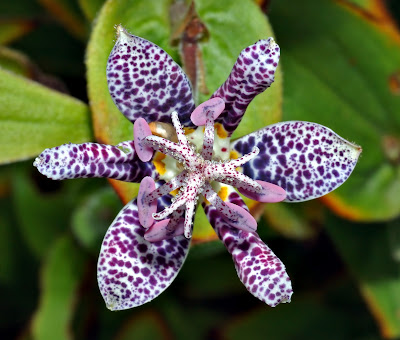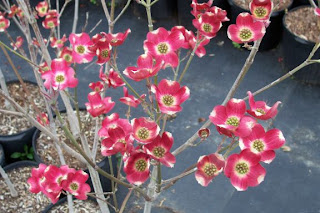Many people mistakenly think that if they have a large area of shade, their options for planting materials are severely limited. They couldn't be more wrong. In fact, some of the most beautiful and unusual plants prefer the shade; most people are amazed at their range of choices.
With a little creativity, even the shadiest area can be transformed into a cool summer paradise. Take advantage of the coolness shade provides by creating a sitting area where you can relax and enjoy a summer day, with a refreshing drink. Surround the area with a variety of plants that will take you through all seasons and make the spot into a magical shady retreat.
Add texture and visual interest by placing boulders and stone strategically and allowing moss to grow on them. Encourage moss growth between stone pavers by blending moss and buttermilk in your blender and then pouring the mixture between the stones. The moss will give your area an old look like it's been there for a hundred years instead of a few months.
Some great choices for shade gardens include (but at not limited to):
Cephalotaxus - This evergreen shrub comes in a huge variety of shapes and sizes, from rounded dwarf shrubs, to urn shaped, to tall slender shrubs that are similar in shape to a Pencil Holly. These shrubs are flexible, however and can tolerate anything from full sun to deep shade.
Toad Lilies - If you have a very deeply shaded area that seems to always stay moist, these flowers are ideal. They grow on long slender stalks and are topped with dramatic pale purple spotted flowers.
Hostas - This is a very versatile perennial that can tolerate anything from partial sun to full shade. They come in a wide variety of colors from the almost blue Wide Brims to the vivid green Stained Glass. They also get a pale lavender bloom on them, once a year.
Columbine - The Columbine is Colorado's state flower and it's a startlingly beautiful option. The plants are small and delicate, but the flowers are dazzling. They come in a variety of shades from crimson to purple to white and are attractive to butterflies and moths.
Some cultivars of Japanese Maples - These would be a lovely addition to any light dappled area in your yard. In Japan, they are considered understory trees and often grow under larger trees.
Heuchera - These plants come in an amazing array of colors: lime green, rose gold, purple, plum, nearly black...and each year new cultivars are discovered and developed. The leaves are large and heartshaped and once a year they send up tall bloom stalks that somewhat resemble hosta blooms.
Ferns - Contrary to the notion that "a fern is a fern is a fern", ferns can be an exciting addition to a shade garden and contribute more than just a fluffy green backdrop. Japanese Painted ferns are a cool mint color, with purple veins, while Autumn Ferns are lovely golden tones.
Camellias - While the older varieties of Camellias tend to be huge (sometimes in excess of 15' tall), some of the newer cultivars are smaller. An especially exciting cultivar of Camellia is the Yuletide Camellia and it blooms right around November or December. It provides a refreshing splash of color when the rest of the plant world is dormant.
Rhododendrons and Azaleas (which are in the Rhododendron family) - These evergreens come in any variety of white, pink, purple, and red. New colors are constantly being introduced in both groups and Encore Azaleas bloom twice a year.
Daphne - Known for their intoxicating fragrance, these shrubs do well in moderately shaded areas and provide an early spring show, before almost anything else is blooming.
Hydrangea - Hydrangeas have come a long way since your grandma's day. Instead of just pink or blue, they now come in a range of colors and shapes including the Lime Light, a tall, leggy shrub, with round, white blooms, Lady in Red, which features red blooms, and stems, and Lacecaps, which feature discs of tiny blooms surrounded by a circle of large blooms (giving them the appearance of...lace caps!)
Dogwood - Once upon a time the most common Dogwoods were white or maybe pale pink, but no longer. Dogwoods can also come in shades of red, green, or deep pink. Kousa dogwoods are fun as well, for not only do they thrive in light shade, but grow tasty sweet, fruits. The fruits themselves are of visual interest; they're deep pink, spherical, and bumpy.

Thursday, April 29, 2010
Thursday, April 8, 2010
Working with water
Going natural
All gardeners know that to have beautiful plants, a little rain must fall, just so long as it's the right amount of rain. Water can make or break a landscape design...too much, and you end up with boggy areas or muddy run-offs. Too little and you run the risk of crisp frying your valuable investment unless you invest lots of time, energy and money into getting your plants the water they need.
In the Guilford County region, we've had more than our fair share of horrendous drought conditions. Who could forget the two year water famine we endured during the summers of 2007 and 2008? Water was rationed, lots of money was spent on irrigation, and still, many people's landscaping investments were lost. It was the worst recorded drought in 110 years. But with every cloud, there truly is a silver lining. The drought caused many people to rethink their ideas about what should be planted in their landscape. New attention was brought to native plants, that thrive in this area and xeriscaping. Xeriscaping is "a landscaping approach that uses small amounts of water but maintains a traditional look" (Xeriscape North Carolina by Dr. Douglas F. Welsh President, National Zeriscape Council, Inc. NCSU). Xeriscaping does not mean you will end up with a yard full of white gravel and cacti; there are many local plants that are lovely and will not just survive our harsh, roasting summers, but thrive in them. Your local garden center can advise you on which plants are native to the area and what will work best for your landscape design. For starters, however, you can consult the State Agricultural Extension's list of drought tolerant plants to get some good ideas.
For further reading about xeriscaping and xerigardening in Guilford county, please check out the great tips offered by the NCSU Cooperative Extension.
Remember, the mighty Grand Canyon was created by just a little trickle of water
Yes, the drought was awful, however, this is North Carolina, and as the saying goes "If you don't like the weather here, just give it a few minutes....it'll change" and according to the almanac, we can expect this summer to be cooler and wetter than normal. That's right, no drought this year (so they say). So all the people who have been fighting runoff-induced erosion, bogging, and other excessive water issues will want to look into their options, this summer. For many, their first instinct is to cover problem areas with paving or install drains, but that's not necessarily a great idea. For starters, you want to keep as much square footage of water permeable landscape as possible. Concrete parking pads, your house roof, stone patios...all of these things prevent water from soaking into the ground like it is supposed to.
What you want to do is slow the water down in the areas where it is eroding your land. The slower the water moves, the more time it has to soak into the ground, and the less damage it can do. The Grand Canyon is an extreme example of what a trickle of fast moving water can accomplish, over time. The solution is to create more areas of water permeability by removing non-permeable elements and slowing the water down. Of course, the roof has to stay and nobody expects you to tear out your patio, but there are other options for reducing run-off, such as parking pads, like the use of gravel, pebbles, Ecogrid, or porous, open cell, concrete block pavers. Downspouts from gutters are another erosion culprit. Many people seek to avoid this by placing a splash block under the drain, in an attempt to spread the distribution of the water. This works to an extent, but in the end, they are still creating a small, non-water permeable area. What works better (and is prettier) is to create an area of pebbles and stone to disperse the water and still allow it to soak into the soil.
For larger areas of runoff erosion, dry creek beds are a beautiful and practical solution. Even very deep and wide areas can be filled with large riprap and then topped with pretty river rock. This way, the water will have to filter through the rocks and riprap, causing it to disperse before it reaches the soil underneath.
The Bog Monster
Then there are those folks, at the other end of the spectrum, where the last thing on Earth they want to do is slow the water down. Maybe their water table is already high, or the clay in their yard is so dense that it takes a while for the water to soak in. Whatever the reason, it can be a real problem, both from a gardening perspective and because it's a great place for mosquitoes to breed. If the boggy area is in a place that would be complimented by plants, then that is fortunate; there are some plants that just love to have wet feet. Lysomachia is a ground cover that loves the water so much, that it will grow into the water if you plant it near a pond. Willows of all kinds are great for soggy areas too, just make sure you don't plant them near your leech field, if you have a septic system because they have a vast root system that will seek out and find any water source.Another way to correct a wet area is to provide drainage, but be careful when doing this; you don't want to correct one problem and create another one (erosion). If the area permits, you could create a dry creek bed, like the one mentioned above. Put some pretty plants around it, build a decorative bridge across it...make it look like you meant for it to be there.
And finally...if you can't beat' em, join 'em. Sometimes the best solution is to just give in...stop fighting nature and just build a pond in the boggy area. Even if you don't put in coy or some other fish, you'll need to make sure the water runs through a fountain, waterfall, or some other filtration system to prevent mosquitoes from breeding in it. As long a body of water is in motion, the mosquitoes will not lay their eggs there. But do consider coy. Watching fish swim lazily in a pond is very relaxing. What sounds more fun to you? Stressing out over the ugly, muddy bog in your back yard or sitting by a picturesque pond, watching the fish glide through the water? Aside from making the best out of a problem area, an added benefit of building a pond is what it does for the ecosystem. Even man made ponds are wonderful habitats for all kinds of small wildlife and plants. Many people feel that ponds are high maintenance, but if done properly, with minor periodic maintenance, the pond will usually take care of itself.
Fun bonus feature of the day!
Speaking of water...
Check out this pondless rock fountain. This carefree custom fountain, does not require regular cleaning, but adds the sounds and texture of a beautiful water feature. Cost ranges from $800- $1200.
Labels:
boggy areas,
drought,
erosion,
fountain,
native plants,
oak ridge shrubbery,
plants,
pond,
problems,
rain,
solutions,
trees,
water,
waterfall,
wet feet,
xerigardening,
xeriscaping
Subscribe to:
Posts (Atom)









